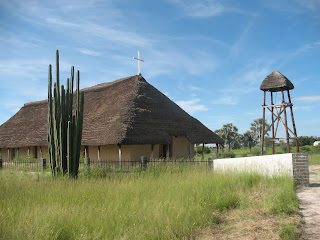 |
| bell tower |
In religion class we have continued to access the role of missionaries in Namibian life. It is important to remember that Christianity didn’t bring religion to Africa. Religion was very much a present force in African society through the centuries and has largely affected behaviors, thoughts and perceptions. It is virtually impossible to explain the culture of Southern Africa without talking about religion. The two are highly interconnected. Christianity came to a Namibia that was deeply religious. It took quite some time for Christians to be baptized, as the natives were suspicious of this new religion and aired on the side of caution. Christian thought carried some similarities to African religions, but brought distinct contrasts. It provided great benefits, but was also profoundly damaging. Christianity changed the face of spirituality in Southern Africa through a different understanding of God and religious practice.
 |
| Finnish missionary church |
Our group got an opportunity to go to the Nakambale museum which demonstrated mission history in northern Namibia, through a study of one of the first Finnish missions as well as traditional Ovambo culture. Before the establishment of church buildings, congregational life occurred under a tree, providing a comforting shady worship space. The first church as part of the mission was built in 1870 and was later enlarged in 1912 with the increasing size of the Finnish church in the region. The building was made form clay and only contained a few seats, with the rest of the space for standing. Back in the day the bells were rung at 9 am, just before the advent of the morning service.
It was interesting to see the method of historical inquiry as the guide seemed to maintain the Ovambo history as the Finnish missionary history. She only had positive things to say about the work of the missionaries, including being the introducers of reading and writing. Later on that day, a student from the Oshigambo High School said she was extremely thankful for the work of the missionaries, stating that we wouldn’t know God without them.
 |
| making the mahangu |
Before missionaries came baby’s names were given based on the time of birth, such as day or night. During the missionary period, names were taken from missionaries and from the bible. In direct contrast, was the cultural history of the Ovambo people. Our time was spent looking at practical contraptions and viewing the traditional homestead. Some of the devices include the uushandja wOshikavango (musical instrument), basket used to store millet, stick for punching mahangu and a mouse trap.
Mahangu flour is made from breaking down graining by punching it with a stick in a small hole in the ground. Often two people take it in turns as one punches the mahangu followed by the other. Songs are sung to pass time in enjoyable company. I got to witness this process at my homestay in the traditional side of the house.
 |
| traditional hut in the Ovambo homestead |
The traditional Ovambo homestead is a maze of wooden sticks containing many separate huts. For example, there is a sleeping hut for the girls, a hut for the house wife close to the kitchen and a much larger hut for the husband right by the cattle. There are even huts for storing items, such as one for beer and other supplies, one for boxes and a dairy hut. The process of making butter takes place in the dairy hut and includes two hours of shaking a container. All in all it was a very intriguing look into the life of traditional Ovambo living and the emersion of mission culture.
It is really pleasing to hear , that we came to know about the bible and started worshiping god , when the missionaries arrived in our South Western Africa.
ReplyDelete